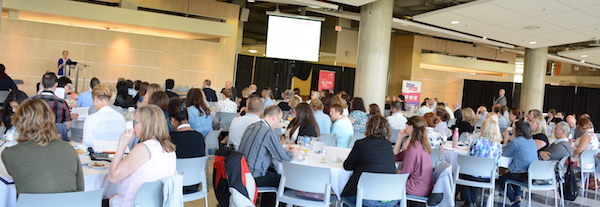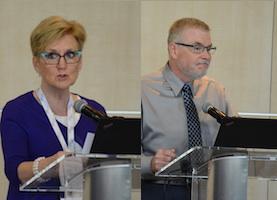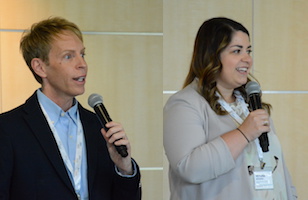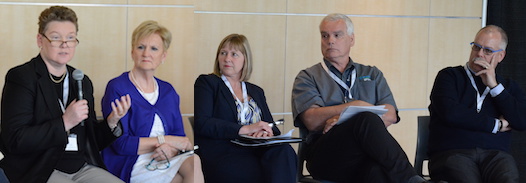Thank you to all the planners, presenters, sponsors and exhibitors who made the 2017 National Forum a huge success! The National Forum brought together patient safety and quality improvement leaders with simulation experts to highlight the many ways simulation techniques are advancing quality and safety at the point of care delivery.

As a sample of the many lessons learned, we heard how:
- The challenge lying ahead for patient safety and quality improvement lies in implementation and culture change, and simulation can be a powerful tool to help achieve this
- Simulation is an investment with returns: A simulation-based program on early sepsis identification reduced septic shock rates, saving $3.21 for every $1 invested
- Interprofessional competencies and teamwork are being advanced with simulation
- Simulation-based orientation to and professional development in critical care improves staff satisfaction and reduces attrition
- With well-established evidence for its effectiveness, it’s time to discuss whether and where simulation should be a required practice
- Simulation can be accessible across sectors and across distance, and does not have to be expensive to be effective
Thank You to the Forum Sponsors & Exhibitors!
- CPSI
- University of Alberta – Faculty of Medicine & Dentistry
- MacEwan University
- HIROC
- Gaumard Scientific
- Health Quality Council of Alberta
- BC Patient Safety & Quality Council
- Laerdal
- Spectrum Nasco
Program & Presentations
After a warm welcoming from Elder Elsie Paul and a powerful reminder of the connection between what we do and its connection to the human spirit, the day was kicked off with further welcomes from Vince Salyers, Dean at MacEwan University, Chris Power, CEO of CPSI, Tim Willett, CEO of SIM-one, and Dan Huffman, Forum planning lead and Director of Alberta’s provincial eSim program.

Keynote Speakers
We were excited to welcome this year’s truly engaging and motivating plenary speakers, Ian Carter and Victoria Brosowsky from WestJet. In this presentation, cabin crew training leaders from WestJet shared their strategies for immersive team training, team engagement, change management, increasing psychological relevance to learners, and associated quality and safety outcomes they have achieved. Thank you to Ian and Victoria for sharing your insights!

Rapid-Fire Panel + Networking
We heard from many leading innovators in 60 minutes, each using simulation in a unique way to advance safety and quality. This was followed by an hour-long networking session so delegates could follow-up with the presenters whose work was most of interest. Titles below are linked to the presentations.
| Interprofessional surgical simulation | Keith Andony & Sue Yorke, Alberta Health Services |
| SIM for Life: Introducing a “Peer Learning Intervention” in Resource Constrained Community Centres in Rural Uganda | Mirette Dube, Alberta Children’s Hospital |
| Simulating the patient’s journey through surgery to detect latent errors | Bin Zheng, University of Alberta |
| Collaborative Care in Action: Using Simulation to Teach Interprofessional Competencies | Mirette Dube, Alberta Health Services – eSIM Provincial Simulation Program |
| Fostering Confidence and Competence Among Critical Care Nurses Through Simulation | Sandra Goldsworthy, University of Calgary |
| Reducing septic shock incidence through simulation-based early recognition training | Michelle Kwong & Janny Proba, Hamilton Health Sciences |
| Ex-Utero Intrapartum Treatment (EXIT) procedure | Sue Barnes, Alberta Health Services |
| Code Blue Blitz – reaching 150 sites with CPR training | Ken Brisbin, Alberta Health Services |

Perspectives Panel
New this year, we introduced a panel of simulation, safety and quality leaders, asking them to respond to questions about the value of simulation, addressing priority safety/quality gaps, increasing its accessibility, interprofessional engagement, driving organizational culture change, and whether simulation should become mandatory. Thank you to Li Peckan, Quality Improvement Officer at Queensway-Carleton Hospital, Chris Power, CEO of CPSI, Kim Dieleman, Manager, Western Region for HIROC, Dan Huffman, Director of Alberta Health Service’s Provincial eSim program, and Neil Gibson, Medical Lead for Acute Care, Edmonton, and Clinical Professor at University of Alberta.

Workshops
Also new this year, we held four small group workshops to allow for deeper dives into key topics on the use of simulation to advance care quality and patient safety.
| Establishing mobile & in-situ sim programs to improve accessibility: What’s really needed? | Alberta Health Services Simulation team |
| Using Human Factors methods and simulation to improve the design of work environments | Jason Laberge & Dan Huffman, Alberta Health Services |
| Organizational SCORS to Mitigate Risk: The Simulation Culture Organizational Readiness Survey (SCORS) | Colette Foisy-Doll, MacEwan University |
| Designing SIM for interprofessionalism, diversity and inclusivity | Darin Abbey, Vancouver Island Health Authority; Sharla King, University of Alberta; Amy Nakajima, Bruyere Continuing Care & SIM-one |

National Simulation Network: Open Meeting
Finally, following the January announcement of the integration of SIM-one and the Canadian Network for Simulation in Healthcare, conference participants joined in an open discussion about evolving this new national network and how it can best engage and support simulation centres and simulationists across Canada.